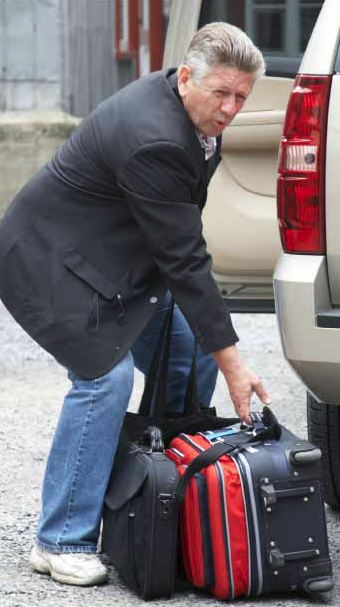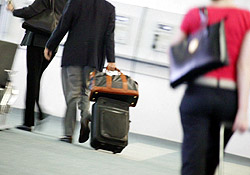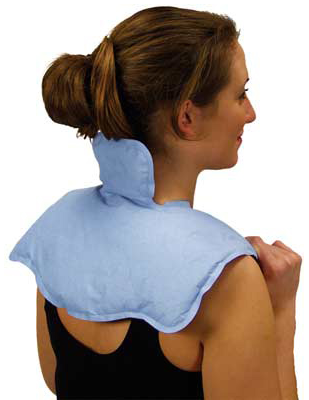Do you have travel plans this holiday season? Follow these simple travel tips to stay pain-free and enjoy your travels from beginning to end.
For many people with back pain or neck pain, the prospect of a long trip can be daunting. The seats in cars, airplanes, buses, and trains aren’t always the most comfortable and sitting still for an extended time can in and of itself aggravate painful areas in the back and neck. The following tips are offered to help reduce or avoid overall back pain and discomfort while traveling.
 Lift Luggage in Stages
Lift Luggage in Stages
Back strain often occurs near the end of one’s range of motion when lifting a heavy item. For this reason, experts recommend moving slowly when lifting a heavy piece of luggage and breaking the action into smaller parts whenever possible. For example, when lifting a bag into an overhead bin, it can first be lifted to the top of the seat, then into the bin in a separate motion. Similarly, loading a suitcase in the trunk of a car can be broken into to steps, such as lifting it first to a chair or stepstool, then lifting it into the trunk. Other important lifting tips include:
- Bend at the knees and use leg muscles rather than back muscles to lift
- Avoid twisting the low back while lifting; instead, pivot with the feet
- Carry heavy items as close to the body as possible
- Distribute weight evenly on each side of the body
- If carrying one shoulder bag, switch sides often to avoid stressing one side of the back
Bring your Own Back Support
Seats in cars, trains, planes etc. often don’t provide the right type of support for the lower back and/or neck. A lumbar support pillow can be used to make your seat more comfortable and support your lower back. If you don’t have one or forget to bring it, a jacket, sweater or blanket rolled up can also provide support for the inward curve of the low back. This is often particularly important if traveling coach class on a long flight, as many airplane seats lack low back support. In this case, an airplane pillow or blanket placed between the seat and low back can work well. An inflatable travel pillow that fits around the neck can help avoid neck strain by providing head support while resting or sleeping in a sitting position during travel.
Support Your Feet
Proper support for the low back also requires bottom-up leverage from your feet. If your feet are not placed on a firm surface while sitting, additional stress is transferred to your low back. Therefore, if your seat is too high, try to rest your feet on a footrest (or something that can act as a footrest) to keep your knees at a right angle and avoid stressing the low back. While driving, resting both feet on the floor provides more support for your lower back than if one foot is on the gas, so you may consider using cruise control for longer drives.
 Pack Light
Pack Light
A heavy bag can be more than just an inconvenience—it can cause or aggravate back pain by straining muscles and joints. To avoid unnecessary strain, it’s best to use a light suitcase with wheels and a handle for rolling it. Even when using a suitcase with wheels, you will probably need to lift it to go up or down stairs, in and out of the car, etc. Therefore, instead of stuffing one large suitcase full, it’s often better to use a few smaller bags. For some trips, the best option is simply to avoid large luggage entirely by shipping most of what you’ll need ahead of time and carrying just one small bag on your trip.
Check Your Posture
Sitting for prolonged periods adds strain to the structures of the low back, and poor posture puts even more stress on your spine. Make sure that your back is aligned against the back of your seat in a sitting position and that your headrest is supporting the middle of your head. Keep the shoulders straight and avoid hunching forward. Make sure both feet are firmly resting on the floor or a footrest. If you are driving, adjust the seat and steering wheel to a comfortable position to avoid reaching for the wheel.
Move as Much as Possible
The spine is designed to move. Sitting in one position for extended periods of time stiffens the back muscles, which can put stress on the spine. Get up and stretch and move around frequently—every 20 to 30 minutes if possible—to move your core body muscles. Importantly, movement stimulates blood flow, and blood brings important nutrients and oxygen to the structures of the back—helping prevent soft tissues in the low back from stiffening and aching after sitting for a long time. Even 10 seconds of movement and stretching is better than sitting still. Movement also helps prevent blood clots from forming in the leg (called deep vein thrombosis), which is one of the most dangerous risks of sitting still for long periods.
Stretch Your Legs and Hips
Sitting can also cause stiffness and tension in the hamstrings (the muscles in the back of the thighs) and hip flexor muscles, which can put pressure on the low back. Keep your hamstrings limber with a standing or sitting hamstring stretch. Options for stretching include:
- Standing hamstring stretch. Bend forward at the waist, keeping the legs relatively straight, and try to touch the toes. Hold this position for 30 to 45 seconds.
- Sitting hamstring stretch. Sit at the edge of a chair and straighten one leg in front of the body with the heel on the floor. Then, sit up straight and try pushing the navel towards the thigh by arching the back, without leaning the trunk of the body forwards. Hold this stretch for 30 seconds, then repeat 3 times for each leg.
Stretch your hip flexor muscles while sitting with this simple technique:
- Sit on the edge of a chair, lean forward, and put one leg behind you as far as you are able, anchoring your toe on the floor.
- Then, sit up straight, keeping your leg behind you. The stretch should be felt in the front of the hip on the side of the leg extended behind you. Hold this position for 30 seconds, then repeat with the opposite leg behind you.
Quick and Easy Pain Relief
 If back pain does flare up while you’re traveling, one of the fastest ways to get relief is applying a cold pack or alternating ice and heat. When traveling, materials such as ice and hot packs are usually easily accessible and affordable. For example, you can fill any type of plastic bag with ice and apply to the painful area—such as placing a small bag of ice between your low back and the seatback while you’re driving or sitting in a plane or train. There are also disposable, portable hot packs that heat up after you open them, so you can bring them on your travels and open and apply them as needed. Commercial heat wraps are available that wrap around the middle of the body and incorporate heating units in the low back area of the band. Such types of heat wraps last for several hours, making them ideal to provide back comfort during lengthy travel. However, too much heat can add to swelling and therefore, alternating ice and heat for 10-15 minutes each, and avoiding prolonged heat is best.
If back pain does flare up while you’re traveling, one of the fastest ways to get relief is applying a cold pack or alternating ice and heat. When traveling, materials such as ice and hot packs are usually easily accessible and affordable. For example, you can fill any type of plastic bag with ice and apply to the painful area—such as placing a small bag of ice between your low back and the seatback while you’re driving or sitting in a plane or train. There are also disposable, portable hot packs that heat up after you open them, so you can bring them on your travels and open and apply them as needed. Commercial heat wraps are available that wrap around the middle of the body and incorporate heating units in the low back area of the band. Such types of heat wraps last for several hours, making them ideal to provide back comfort during lengthy travel. However, too much heat can add to swelling and therefore, alternating ice and heat for 10-15 minutes each, and avoiding prolonged heat is best.
The above guidelines outline several steps you can take to help lessen your chances of pain during a long trip. Awareness of common mistakes such as those mentioned above will help you to avoid aggravating your pain with improper lifting or sitting postures. Thinking ahead about ways to make yourself comfortable during travel can help to remove the stress of traveling and ultimately make your journey more pleasurable.
Source: www.spine-health.com; Ron Miller, PT; December 6, 2005








